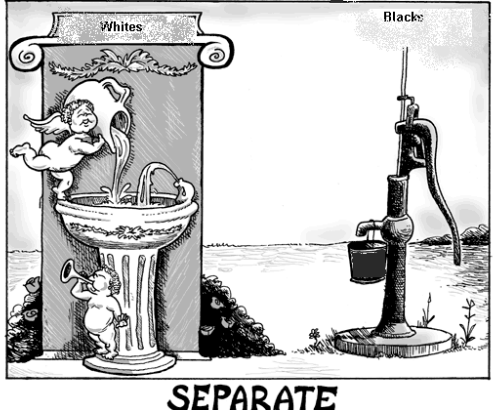“Separate but equal” was the infamous justification for the decision in Plessy v Ferguson, the case that formally legalized segregation.
The justification behind the decision was that segregation was constitutional as long as both black and white Americans had equal protection under the law.
This doctrine allowed states to maintain racially segregated facilities, as long as they were purportedly equal.
However, the facilities and services provided to African Americans were vastly inferior to those provided to white citizens.
The pervasive segregation fostered under “separate but equal” had profound social, economic, and educational repercussions.
It reinforced racial hierarchies, widened socioeconomic disparities, and cemented racial prejudice and discrimination within American society.
This era saw African Americans facing immense adversity including disenfranchisement, violence, and profound social and economic marginalization.

The 1956 Brown v Board of Education case would overturn the separate but equal doctrine, saying that separate could not possibly be equal.
As Time reported:
The case reached the Supreme Court in 1896, and the court ruled that Louisiana’s law, calling for ‘equal but separate’ facilities on trains, was constitutional. The majority opinion held that Negroes were equal to whites ‘civilly and politically,’ but not ‘socially.’
In 1954, with Brown v. Board of Education, the Supreme Court finally declared what Americans could long have seen with their own eyes: that which was kept separate was inherently unequal.
This ruling acknowledged that segregated facilities were inherently unequal, marking a legal and moral victory against institutionalized racism.
However, the legacy of “separate but equal” continues to resonate, as the United States grapples with systemic racial disparities and the enduring impact of segregation.
The dialogue around racial equality, educational equity, and social justice remains significantly shaped by the historical shadow of the “separate but equal” doctrine.
Use of “Separate but Equal” in a sentence
- The doctrine of “separate but equal” was a legal principle upheld by the United States Supreme Court in the 1896 case Plessy v. Ferguson, which allowed state-sponsored segregation so long as the facilities provided to each race were ostensibly equal.
- The infamous “separate but equal” policy was ultimately dismantled through the landmark 1954 Supreme Court decision in Brown v. Board of Education, which recognized that segregated facilities were inherently unequal and violated the Equal Protection Clause of the 14th Amendment.
- Discussions around the historical impact of the “separate but equal” doctrine continue to resonate in modern political discourse, particularly when examining systemic racial disparities and the legacy of segregation in America.